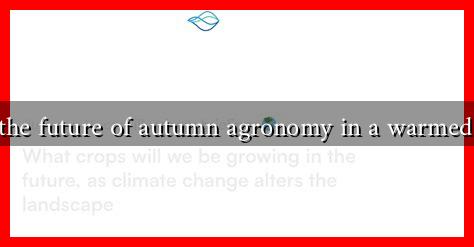-
Table of Contents
- What is the Future of Autumn Agronomy in a Warmed Climate?
- The Impact of Climate Change on Autumn Agronomy
- Opportunities for Innovation in Autumn Agronomy
- Case Studies: Successful Adaptations in Autumn Agronomy
- Statistics Highlighting the Need for Change
- Conclusion: Preparing for the Future of Autumn Agronomy
What is the Future of Autumn Agronomy in a Warmed Climate?
As global temperatures continue to rise, the implications for agriculture are profound, particularly for autumn agronomy. The changing climate is reshaping the agricultural landscape, affecting crop yields, pest dynamics, and farming practices. This article explores the future of autumn agronomy in a warmed climate, examining the challenges and opportunities that lie ahead.
The Impact of Climate Change on Autumn Agronomy
Climate change is altering the traditional growing seasons, with autumn becoming a critical period for many crops. The following factors illustrate how a warmed climate is influencing autumn agronomy:
- Temperature Increases: Warmer autumns can lead to extended growing seasons, allowing farmers to plant crops later in the year. However, this can also result in heat stress for certain crops.
- Altered Precipitation Patterns: Changes in rainfall can lead to droughts or excessive moisture, impacting soil health and crop viability.
- Pest and Disease Pressure: Warmer temperatures can expand the range of pests and diseases, posing new challenges for farmers.
Opportunities for Innovation in Autumn Agronomy
Despite the challenges posed by climate change, there are also opportunities for innovation in autumn agronomy. Farmers and researchers are exploring various strategies to adapt to the changing climate:
- Crop Diversification: Introducing a wider variety of crops can enhance resilience against climate variability. For instance, farmers in the Midwest are increasingly planting cover crops to improve soil health and reduce erosion.
- Precision Agriculture: Utilizing technology such as drones and soil sensors can help farmers make data-driven decisions, optimizing inputs and improving yields.
- Climate-Resilient Varieties: Breeding programs are focusing on developing crop varieties that can withstand heat and drought, ensuring food security in a warming world.
Case Studies: Successful Adaptations in Autumn Agronomy
Several regions are already implementing innovative practices to adapt to the changing climate. Here are a few notable examples:
- California’s Almond Growers: Facing prolonged droughts, almond farmers are adopting water-efficient irrigation techniques and planting drought-resistant varieties to sustain their crops.
- European Farmers: In countries like Germany and France, farmers are experimenting with late-sown crops such as winter barley, which can thrive in warmer autumns and provide a reliable yield.
- Australian Grain Producers: In response to increasing temperatures, Australian farmers are shifting to more heat-tolerant wheat varieties and adjusting planting dates to align with changing weather patterns.
Statistics Highlighting the Need for Change
The urgency for adaptation in autumn agronomy is underscored by several statistics:
- According to the Intergovernmental Panel on Climate Change (IPCC), global temperatures are projected to rise by 1.5°C above pre-industrial levels by as early as 2030.
- The Food and Agriculture Organization (FAO) estimates that climate change could reduce crop yields by up to 30% by 2050 if no adaptation measures are taken.
- A study published in the journal Agricultural Systems found that adopting climate-smart agricultural practices could increase yields by 20-30% in some regions.
Conclusion: Preparing for the Future of Autumn Agronomy
The future of autumn agronomy in a warmed climate presents both challenges and opportunities. As temperatures rise and weather patterns shift, farmers must adapt their practices to ensure sustainable food production. By embracing innovation, diversifying crops, and utilizing technology, the agricultural sector can navigate the complexities of a changing climate. The examples and statistics highlighted in this article underscore the importance of proactive measures in securing the future of autumn agronomy. As we move forward, collaboration among farmers, researchers, and policymakers will be essential in fostering resilience and sustainability in agriculture.


